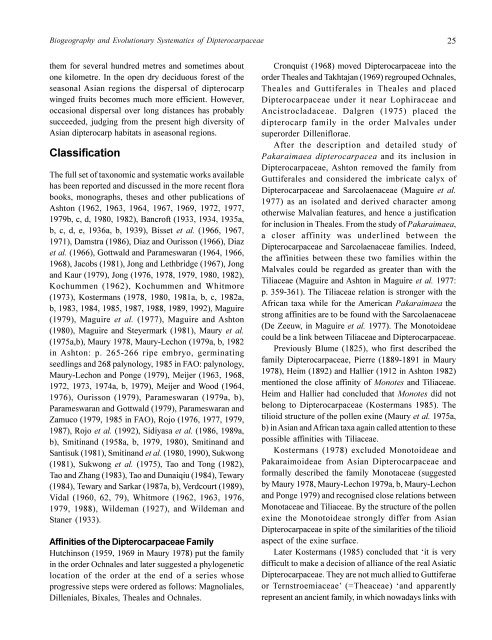A review of dipterocarps - Center for International Forestry Research
A review of dipterocarps - Center for International Forestry Research
A review of dipterocarps - Center for International Forestry Research
Create successful ePaper yourself
Turn your PDF publications into a flip-book with our unique Google optimized e-Paper software.
Biogeography and Evolutionary Systematics <strong>of</strong> Dipterocarpaceae<br />
them <strong>for</strong> several hundred metres and sometimes about<br />
one kilometre. In the open dry deciduous <strong>for</strong>est <strong>of</strong> the<br />
seasonal Asian regions the dispersal <strong>of</strong> dipterocarp<br />
winged fruits becomes much more efficient. However,<br />
occasional dispersal over long distances has probably<br />
succeeded, judging from the present high diversity <strong>of</strong><br />
Asian dipterocarp habitats in aseasonal regions.<br />
Classification<br />
The full set <strong>of</strong> taxonomic and systematic works available<br />
has been reported and discussed in the more recent flora<br />
books, monographs, theses and other publications <strong>of</strong><br />
Ashton (1962, 1963, 1964, 1967, 1969, 1972, 1977,<br />
1979b, c, d, 1980, 1982), Bancr<strong>of</strong>t (1933, 1934, 1935a,<br />
b, c, d, e, 1936a, b, 1939), Bisset et al. (1966, 1967,<br />
1971), Damstra (1986), Diaz and Ourisson (1966), Diaz<br />
et al. (1966), Gottwald and Parameswaran (1964, 1966,<br />
1968), Jacobs (1981), Jong and Lethbridge (1967), Jong<br />
and Kaur (1979), Jong (1976, 1978, 1979, 1980, 1982),<br />
Kochummen (1962), Kochummen and Whitmore<br />
(1973), Kostermans (1978, 1980, 1981a, b, c, 1982a,<br />
b, 1983, 1984, 1985, 1987, 1988, 1989, 1992), Maguire<br />
(1979), Maguire et al. (1977), Maguire and Ashton<br />
(1980), Maguire and Steyermark (1981), Maury et al.<br />
(1975a,b), Maury 1978, Maury-Lechon (1979a, b, 1982<br />
in Ashton: p. 265-266 ripe embryo, germinating<br />
seedlings and 268 palynology, 1985 in FAO: palynology,<br />
Maury-Lechon and Ponge (1979), Meijer (1963, 1968,<br />
1972, 1973, 1974a, b, 1979), Meijer and Wood (1964,<br />
1976), Ourisson (1979), Parameswaran (1979a, b),<br />
Parameswaran and Gottwald (1979), Parameswaran and<br />
Zamuco (1979, 1985 in FAO), Rojo (1976, 1977, 1979,<br />
1987), Rojo et al. (1992), Sidiyasa et al. (1986, 1989a,<br />
b), Smitinand (1958a, b, 1979, 1980), Smitinand and<br />
Santisuk (1981), Smitinand et al. (1980, 1990), Sukwong<br />
(1981), Sukwong et al. (1975), Tao and Tong (1982),<br />
Tao and Zhang (1983), Tao and Dunaiqiu (1984), Tewary<br />
(1984), Tewary and Sarkar (1987a, b), Verdcourt (1989),<br />
Vidal (1960, 62, 79), Whitmore (1962, 1963, 1976,<br />
1979, 1988), Wildeman (1927), and Wildeman and<br />
Staner (1933).<br />
Affinities <strong>of</strong> the Dipterocarpaceae Family<br />
Hutchinson (1959, 1969 in Maury 1978) put the family<br />
in the order Ochnales and later suggested a phylogenetic<br />
location <strong>of</strong> the order at the end <strong>of</strong> a series whose<br />
progressive steps were ordered as follows: Magnoliales,<br />
Dilleniales, Bixales, Theales and Ochnales.<br />
25<br />
Cronquist (1968) moved Dipterocarpaceae into the<br />
order Theales and Takhtajan (1969) regrouped Ochnales,<br />
Theales and Guttiferales in Theales and placed<br />
Dipterocarpaceae under it near Lophiraceae and<br />
Ancistrocladaceae. Dalgren (1975) placed the<br />
dipterocarp family in the order Malvales under<br />
superorder Dilleniflorae.<br />
After the description and detailed study <strong>of</strong><br />
Pakaraimaea dipterocarpacea and its inclusion in<br />
Dipterocarpaceae, Ashton removed the family from<br />
Guttiferales and considered the imbricate calyx <strong>of</strong><br />
Dipterocarpaceae and Sarcolaenaceae (Maguire et al.<br />
1977) as an isolated and derived character among<br />
otherwise Malvalian features, and hence a justification<br />
<strong>for</strong> inclusion in Theales. From the study <strong>of</strong> Pakaraimaea,<br />
a closer affinity was underlined between the<br />
Dipterocarpaceae and Sarcolaenaceae families. Indeed,<br />
the affinities between these two families within the<br />
Malvales could be regarded as greater than with the<br />
Tiliaceae (Maguire and Ashton in Maguire et al. 1977:<br />
p. 359-361). The Tiliaceae relation is stronger with the<br />
African taxa while <strong>for</strong> the American Pakaraimaea the<br />
strong affinities are to be found with the Sarcolaenaceae<br />
(De Zeeuw, in Maguire et al. 1977). The Monotoideae<br />
could be a link between Tiliaceae and Dipterocarpaceae.<br />
Previously Blume (1825), who first described the<br />
family Dipterocarpaceae, Pierre (1889-1891 in Maury<br />
1978), Heim (1892) and Hallier (1912 in Ashton 1982)<br />
mentioned the close affinity <strong>of</strong> Monotes and Tiliaceae.<br />
Heim and Hallier had concluded that Monotes did not<br />
belong to Dipterocarpaceae (Kostermans 1985). The<br />
tilioid structure <strong>of</strong> the pollen exine (Maury et al. 1975a,<br />
b) in Asian and African taxa again called attention to these<br />
possible affinities with Tiliaceae.<br />
Kostermans (1978) excluded Monotoideae and<br />
Pakaraimoideae from Asian Dipterocarpaceae and<br />
<strong>for</strong>mally described the family Monotaceae (suggested<br />
by Maury 1978, Maury-Lechon 1979a, b, Maury-Lechon<br />
and Ponge 1979) and recognised close relations between<br />
Monotaceae and Tiliaceae. By the structure <strong>of</strong> the pollen<br />
exine the Monotoideae strongly differ from Asian<br />
Dipterocarpaceae in spite <strong>of</strong> the similarities <strong>of</strong> the tilioid<br />
aspect <strong>of</strong> the exine surface.<br />
Later Kostermans (1985) concluded that ‘it is very<br />
difficult to make a decision <strong>of</strong> alliance <strong>of</strong> the real Asiatic<br />
Dipterocarpaceae. They are not much allied to Guttiferae<br />
or Ternstroemiaceae’ (=Theaceae) ‘and apparently<br />
represent an ancient family, in which nowadays links with

















